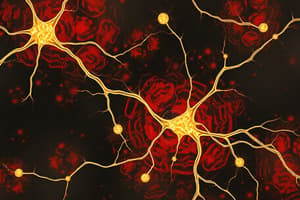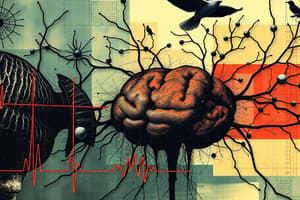Podcast
Questions and Answers
What role do action potentials play in neuronal communication?
What role do action potentials play in neuronal communication?
How do neurons primarily communicate with each other?
How do neurons primarily communicate with each other?
What is necessary to create an action potential in neurons?
What is necessary to create an action potential in neurons?
Which of the following statements about resting membrane potential is correct?
Which of the following statements about resting membrane potential is correct?
Signup and view all the answers
What happens when an action potential travels down the axon?
What happens when an action potential travels down the axon?
Signup and view all the answers
Which of the following best describes the propagation of an action potential?
Which of the following best describes the propagation of an action potential?
Signup and view all the answers
What occurs at the synapse between two neurons?
What occurs at the synapse between two neurons?
Signup and view all the answers
What is a primary function of neurotransmitters in neuronal communication?
What is a primary function of neurotransmitters in neuronal communication?
Signup and view all the answers
Which of the following is NOT a reason electrical signals are important in neurons?
Which of the following is NOT a reason electrical signals are important in neurons?
Signup and view all the answers
Which ion primarily determines the resting membrane potential in neurons?
Which ion primarily determines the resting membrane potential in neurons?
Signup and view all the answers
What is the resting membrane potential (RMP) of skeletal muscle cells?
What is the resting membrane potential (RMP) of skeletal muscle cells?
Signup and view all the answers
What equation is used to predict the equilibrium potential for ions?
What equation is used to predict the equilibrium potential for ions?
Signup and view all the answers
How does the Na+ pump contribute to maintaining the resting membrane potential?
How does the Na+ pump contribute to maintaining the resting membrane potential?
Signup and view all the answers
What factors are essential for the production and maintenance of the resting membrane potential?
What factors are essential for the production and maintenance of the resting membrane potential?
Signup and view all the answers
Which statement best describes the membrane potential at any time?
Which statement best describes the membrane potential at any time?
Signup and view all the answers
What is the primary reason K+ contributes significantly to the resting membrane potential?
What is the primary reason K+ contributes significantly to the resting membrane potential?
Signup and view all the answers
What is the role of Na+ channels in the resting membrane potential?
What is the role of Na+ channels in the resting membrane potential?
Signup and view all the answers
In which type of cell is the resting membrane potential estimated to be between -7 mv to -14 mv?
In which type of cell is the resting membrane potential estimated to be between -7 mv to -14 mv?
Signup and view all the answers
What primarily determines the resting membrane potential (RMP) of neurons?
What primarily determines the resting membrane potential (RMP) of neurons?
Signup and view all the answers
Which type of ion channels randomly open and close without a stimulus?
Which type of ion channels randomly open and close without a stimulus?
Signup and view all the answers
What initiates the activation of ligand-gated channels?
What initiates the activation of ligand-gated channels?
Signup and view all the answers
Which statement about gated ion channels is true?
Which statement about gated ion channels is true?
Signup and view all the answers
Which ion is most relevant for leak channels in neurons?
Which ion is most relevant for leak channels in neurons?
Signup and view all the answers
Where are voltage-gated channels primarily located in neurons?
Where are voltage-gated channels primarily located in neurons?
Signup and view all the answers
What best describes the action potential (AP)?
What best describes the action potential (AP)?
Signup and view all the answers
Which mechanical stimuli activate mechanically-gated channels?
Which mechanical stimuli activate mechanically-gated channels?
Signup and view all the answers
What is the typical range for the resting membrane potential (RMP) in neurons?
What is the typical range for the resting membrane potential (RMP) in neurons?
Signup and view all the answers
What ions are primarily responsible for the RMP difference across the neuronal membrane?
What ions are primarily responsible for the RMP difference across the neuronal membrane?
Signup and view all the answers
Flashcards
Electrical Signals
Electrical Signals
Signals used by neurons to transmit information to other cells.
Neuronal Communication
Neuronal Communication
Process by which neurons exchange signals via electrical activity or neurotransmitters.
Action Potentials
Action Potentials
Rapid electrical impulses that travel along axons to facilitate communication.
Neurotransmitters
Neurotransmitters
Signup and view all the flashcards
Axon
Axon
Signup and view all the flashcards
Resting Membrane Potential
Resting Membrane Potential
Signup and view all the flashcards
Propagation of Action Potential
Propagation of Action Potential
Signup and view all the flashcards
Cell-cell Communication
Cell-cell Communication
Signup and view all the flashcards
Electrical Activity
Electrical Activity
Signup and view all the flashcards
Information Transmission
Information Transmission
Signup and view all the flashcards
Ion Channels
Ion Channels
Signup and view all the flashcards
Leak Channels
Leak Channels
Signup and view all the flashcards
Gated Channels
Gated Channels
Signup and view all the flashcards
Ligand-Gated Channels
Ligand-Gated Channels
Signup and view all the flashcards
Mechanically-Gated Channels
Mechanically-Gated Channels
Signup and view all the flashcards
Voltage-Gated Channels
Voltage-Gated Channels
Signup and view all the flashcards
Ion Concentrations
Ion Concentrations
Signup and view all the flashcards
Neuronal Activation
Neuronal Activation
Signup and view all the flashcards
Equilibrium Potential
Equilibrium Potential
Signup and view all the flashcards
Nernst Equation
Nernst Equation
Signup and view all the flashcards
Goldman Field Equation
Goldman Field Equation
Signup and view all the flashcards
Resting Membrane Potential (RMP)
Resting Membrane Potential (RMP)
Signup and view all the flashcards
Membrane Permeability
Membrane Permeability
Signup and view all the flashcards
Sodium-Potassium Pump
Sodium-Potassium Pump
Signup and view all the flashcards
K+ Permeability
K+ Permeability
Signup and view all the flashcards
Threshold Potential
Threshold Potential
Signup and view all the flashcards
Study Notes
Lecture 2 PHCL2610: Nervous System
- Lecturer: Ana Maria Oyarce Ph.D.
- Department: Pharmacology - HEB280C
- Office hours: TBD or by appointment
- Phone: (419)383-1919
- Email: [email protected]
Topics
-
Electrical Signals
-
Channels
-
Resting Membrane Potential
-
Material: Vander's Human Physiology 16th Edition, Copyright 2023, Chapter 6, Section B: Membrane Potentials
Neuronal Communication
- Neurons communicate using specific signals.
- Cell-cell communication happens through electrical activity or neurotransmitter release.
Why Electrical Signals in Neurons are Important?
- Electrical signals (action potentials/nervous impulses) transmit information between neurons and other cells.
- Action potentials are crucial for cell-cell communication.
- Action potentials travel along the axon, triggering electrical activity or neurotransmitter release in the next cell.
Electrical Signals in Neurons
- Neurons at rest exhibit a resting membrane potential (RMP).
- Activated neurons produce action potentials (APs).
- RMP and AP production depend on ion concentration differences inside and outside the neuron.
- The lipid bilayer of the plasma membrane acts as an insulator, and ion movement occurs through ion channels embedded in the membrane.
- Ion channels open or close in response to specific stimuli.
Types of Ion Channels
- Ion channels are present in the plasma membrane.
- Classified based on activation mechanism:
- Leak/passive (non-gated) channels: randomly open and close.
- Gated channels: open or close in response to a stimulus.
Leak or Passive Channels
- Permeability to ions is high.
- Channels alternate between open and closed positions.
- Leak channels in neurons are primarily K+, Na+, and Cl-.
- K+ is most relevant.
- Present in all cells, including dendrites, cell bodies, and axons of neurons.
Gated-Ion Channels
- Three main types based on activation:
- Ligand-gated channels
- Mechanically gated channels
- Voltage-gated channels
Ligand-Gated Channel
- Binding of a ligand (e.g., neurotransmitter, hormone, ion) to a ligand-gated channel changes its permeability to an ion.
- Primarily located in dendrites and cell bodies, concentrating at the synapse.
Mechanically-Gated Channels
- Mechanical stimuli (e.g., vibration, touch, pressure) induce conformational changes in the receptor, activating the channel.
- Found in receptors of auditory, internal organs, and skin.
Voltage-Gated Channels
- Activate in response to changes in membrane potential.
- Exhibit ion selectivity.
- Crucial for action potential generation and propagation.
- Found along unmyelinated axons, nodes of Ranvier (myelinated axons), and the axon hillock.
Membrane Potentials
- Resting membrane potential (RMP): Voltage difference across the membrane when the cell isn't stimulated.
- Action potential (AP): Brief reversal in membrane potential following neuron activation.
Resting Membrane Potential
- RMP is due to differences in ion concentrations across the membrane.
- RMP in neurons is typically between -40 and -90 mV (typically -70 mV).
- Negative charges are inside the neuron, and positive charges are outside.
- Distribution of K+ and Na+ ions is key. (Inside Neuron: High K+, Outside Neuron: High Na+.)
Why an Electrical Potential is Generated?
- Equal K+ concentration on both sides, no net flux of K+ indicates closed channels.
- K+ movement generates a charge difference.
- Electrical potential opposes further K+ movement.
- Electrical potential matches concentration gradient. This is known as the electrochemical equilibrium.
- Same principle applies to other ions.
Nernst Equation
- Predicts the equilibrium potential for an ion.
- Includes ion concentration inside and outside cells, charge, universal gas constant, temperature, and Faraday's constant.
Several Ions Contribute to The Membrane Potential
- Membrane potential depends on K+, Cl-, and Na+.
- The Goldman Field Equation describes the membrane potential, considering ion concentrations and membrane permeabilities to each ion.
- The neuron's membrane potential is most influenced by the ion with the highest permeability. (Most permeable ion is K+ for neurons.)
Resting Membrane Potential (cont.)
- The magnitude of the resting potential depends on:
- Differences in specific ion concentrations.
- Differences in membrane permeability to ions. (Number of channels open.)
- All cells have a resting membrane potential. (e.g., skeletal muscle = -90 mV, neurons = -70 mV, red blood cell = -7 to -14 mV.)
How is the RMP Produced and Maintained?
- Leak channels for K+ and Na+ are open at rest.
- K+ diffuses out of the neuron (high permeability).
- Na+ slightly leaks into the neuron.
- The sodium-potassium pump maintains RMP by actively transporting Na+ out and K+ into the neuron. (Maintains RMP equilibrium by using ATP.)
Studying That Suits You
Use AI to generate personalized quizzes and flashcards to suit your learning preferences.
Related Documents
Description
Explore the fundamentals of the nervous system in Lecture 2 of PHCL2610. This quiz covers essential topics such as electrical signals, resting membrane potential, and neuronal communication. Gain a deeper understanding of how neurons transmit crucial information through action potentials.





